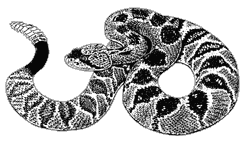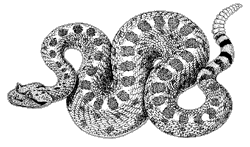Rattlesnakes
Representative Sonoran Desert species:
western diamondback (Crotalus atrox)
mohave rattlesnake (Crotalus scutulatus)
tiger rattlesnake (Crotalus tigris)
blacktail rattlesnake (Crotalus molossus)
sidewinder (Crotalus cerastes)
Order: Squamata
Family: Viperidae (moveable front-fang venomous snakes)
Spanish names: víbora de cascabel (rattlesnake), víbora de cuernitos (sidewinder)
Distinguishing Features
Western diamondback: Dark, diamond-shaped or hexagonal blotches along the center of the back, light eye stripe from eye to upper lip, bold black and white tail banding, small scales on head.
Mohave rattlesnake: Difficult to distinguish from western diamondback; tail generally has narrower black bands than white, 2 to 3 enlarged scales on top of the head between the eyes.
Tiger rattlesnake: Small head and large rattle, 35 to 52 distinct closely-spaced crossbands on back and sides. Blacktail rattlesnake: Black tail and snout.
Sidewinder: Horn-like projection over each eye.
Habitat
The western diamondback is a generalist which can be found in diverse habitats from below sea level to 6500 feet (2000 m). The Mohave rattlesnake prefers open areas with grasses, creosote bush, palo verde, mesquite and cactus; most common at lower elevations; also common in desert grasslands of southeast Arizona; usually not present in rocky areas or areas with heavy vegetation. The tiger rattlesnake is strictly a Sonoran Desert region species; most common in very rocky canyons and foothills or arid desert mountains up to 4800 feet (1460 m); usually restricted to cactus and mesquite of the rocky foothills; seldom encountered in flat, sandy areas devoid of rocks. The blacktail is primarily a mountain snake found in pinyon-oak woodland or coniferous forests up to 9600 feet (2900 m) near rocky areas; also resides in saguaro-covered desert uplands. The Sidewinder is a common resident of sand dunes and other loose, sandy areas where vegetation is sparse and composed primarily of creosote bush; rarely seen in rocky areas.
Click here to hear rattlesnake sounds
 |
Feeding
• Diet: Rodents make up the majority of the diet for all of these snakes. Birds, lizards and other small animals are also taken.
Life History
Western diamondback: This snake is active at night during the warm months and during the day in spring and fall; it returns to rocky cliffs for a winter hibernation period, but may exit to bask in the sun on warm days.
Mohave RattlerThe Mohave rattlesnake may be the most dangerous venomous snake in the Sonoran Desert. Quick to go on the defensive, the Mohave has very toxic venom that has caused human fatalities. Venom toxicity varies among different populations. The seriousness of a bite from this rattlesnake, as from any rattlesnake, depends on many factors, including, but not limited to, the amount of venom injected and the health and size of the victim. A person bitten by a Mohave rattlesnake should seek medical attention immediately. |
Prior to copulation in the spring, male diamondbacks (as well as males of at least some other rattlesnake species) perform well-documented, ritualized “combat dances.” When two males encounter each other they raise their bodies off the ground—as much as one-third of their lengths. Belly-to-belly, they begin an intense wrestling contest. Occasionally one snake or the other falls to the ground, only to rise up to continue the contest anew. This wrestling match may continue for thirty minutes or more. At some point, one snake finally gives up and crawls away, often with the victor in hot pursuit. Victors have even been observed climbing into shrubs several feet off the ground, apparently to make sure the loser does not try to return to the females. There are occasions when a third male is present. He does not join the duo at battle, but instead copulates with the females while the other two males are battling. Biologists have termed this the “sneaky male strategy.” The inseminated female will give birth to as many as 23, 9- to 14-inch-long (23-36 cm) young in the late summer. Young diamondbacks feed on rodents, and adults also eat rabbits and ground-dwelling birds.
Mohave rattlesnake: The Mohave is active primarily at night from February to November. Unlike most rattlesnakes, which usually hibernate in larger groups, the Mohave hibernates singly or in pairs or trios in rodent burrows. Courtship and copulation occur in the spring or, occasionally, in the fall. Following fall copulation, sperm may be viably retained for several months, resulting in births during the next year’s warmer seasons. As many as 13, 9-inch-long (23 cm) young are usually born in late summer and early fall. Rodents comprise the bulk of the diet.
Tiger rattlesnake: While this snake is active from spring through late fall, its peak of activity correlates with the summer monsoons. Though not rare, it is rarely seen; it is primarily nocturnal. Mating occurs in April, with 4 to 6, 9-inch-long (23 cm) young born late June through September. The tiger rattlesnake fang is proportionately shorter than that of other rattlesnakes; the venom is strong. Tiger rattlesnakes eat lizards and rodents; juveniles generally favor lizards more than do adults. Though these are small rattlesnakes, they have been known to eat fairly large prey, including kangaroo rats, packrats, and even spiny lizards!
 |
Blacktail rattlesnake: This snake often climbs into the lower branches of trees and shrubs several feet off the ground to bask in the sun or to feed on birds. It also readily eats mammals and lizards. Born in mid-summer, the young number 3 to 16, about 1 foot long (30 cm). Like many rattlesnakes, the blacktail is not aggressive nor easily alarmed and may not rattle if approached.
Sidewinder: Where it is warm throughout the year, the sidewinder is active year-round. During the summer the sidewinder seeks shelter during the day, retreating to animal burrows or burying itself in the sand under the shade of a creosote bush. It ventures out at night to eat lizards, small snakes, birds and mammals. During cooler seasons sidewinders may be diurnal (active during the day) or crepuscular (active at dusk or dawn). In areas where hibernation does occur, the sidewinder hibernates singly in a rodent burrow, or occasionally in a desert tortoise burrow. Copulation occurs in the spring, and 5 to 18 young, 6¼ to 8 inches (16-20 cm) long, are born in late summer and fall.
Sidewinding
While many snakes use the method of locomotion called “sidewinding, ”the sidewinder is particularly adept at it. Sidewinding is a method of locomotion adapted for areas with loose, hot, sandy soils where traction is difficult. To sidewind, the snake throws a loop of its body forward and then pulls itself up on the loop. As the loop is thrown forward, the head and neck of the snake push down into the sand. In this way much of the snake’s body is held up off the hot surface. To the observer, the sidewinding snake appears to be going sideways with respect to the direction in which the body points. While sidewinding is the primary form of locomotion for a sidewinder, it can also use all other methods of locomotion characteristic of snakes. (See rosy boa account )
Additional Readings
Brown, David E. and Neil B. Carmony. Gila Monster: Facts and Folklore of America’s Aztec Lizard. Silver City, NM: High-Lonesome Books, 1991.
Campbell, Jonathan A. and William W. Lamar. The Venomous Reptiles of Latin America. New York: Cornell University, 1989.
Ernst, Carl H. Venomous Reptiles of North America. Washington, DC: Smithsonian Institution Press, 1992.
Ernst, Carl H. and Roger W. Barbour. Turtles of the World. Washington, DC: Smithsonian Institution Press, 1989.
Greene, Harry W. Snakes: The Evolution of Mystery in Nature. Berkeley: University of California Press, 1997.
Klauber, Laurence M. Rattlesnakes: Their Habits, Life Histories and Influence on Mankind. Berkeley: University of California Press, 1997.
Stebbins, Robert C. Field Guide to Western Reptiles and Amphibians. Boston: Houghton Mifflin, 1985.
Stebbins, Robert C. and Nathan W. Cohen. A Natural History of Amphibians. Princeton, NJ: Princeton University Press, 1997.
Wright, John W. and Laurie J. Vitt, eds. Biology of Whiptail Lizards: A Genus Cnemidophorus. Norman, OK: Oklahoma Museum of Natural History, 1993.










